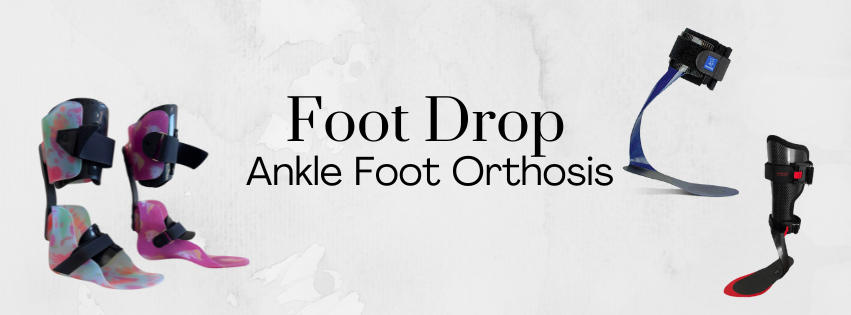Rebound O&P
Updated 7:55 PM CDT, Mon March 10, 2025
Published Under: Orthotics

Foot drop, also known as drop foot, is a condition that affects the ability to lift the front part of the foot. This can lead to difficulties in walking, increased risk of tripping, and overall mobility challenges. In this blog, we’ll explore the causes, symptoms, diagnosis, and treatment options for foot drop, providing a comprehensive overview for those affected and their caregivers.
What is Foot Drop?
Foot drop is characterized by weakness or paralysis of the muscles involved in dorsiflexion—the action of raising the foot at the ankle. As a result, individuals with foot drop may find it difficult to lift their foot when walking, leading to a characteristic gait where the foot drags or slaps on the ground. This condition can affect one or both feet and can significantly impact daily activities and quality of life.
Causes of Foot Drop
Several factors can contribute to the development of foot drop, including:
- Nerve Injuries: The most common cause of foot drop is injury to the peroneal nerve, which controls the muscles that lift the foot. This can occur from:
- Trauma to the knee or lower leg
- Compression due to prolonged pressure, such as sitting cross-legged for extended periods
- Neurological Conditions: Various neurological disorders can lead to foot drop, including:
- Stroke: Damage to the areas of the brain that control muscle movement can result in weakness or paralysis.
- Multiple Sclerosis: This condition can affect the nerve signals that control movement, leading to foot drop.
- Cerebral Palsy: Children with cerebral palsy may experience foot drop due to muscle weakness and coordination issues.
- Muscle Disorders: Certain conditions that affect muscle function can also lead to foot drop, such as:
- Muscular Dystrophy: This genetic disorder causes progressive muscle weakness and degeneration.
- Charcot-Marie-Tooth Disease: A hereditary neuropathy that affects peripheral nerves and can cause weakness in the foot.
- Spinal Issues: Herniated discs or spinal stenosis can compress nerves that lead to the foot, resulting in drop foot.
Symptoms of Foot Drop
The primary symptom of foot drop is the inability to lift the front part of the foot. Other related symptoms may include:
- Dragging the Foot: The foot may drag along the ground while walking, leading to tripping or stumbling.
- Slapping Gait: The foot may make a slapping sound when it hits the ground due to the lack of control.
- Difficulty Navigating Stairs: Individuals may struggle with climbing or descending stairs.
- Fatigue: The increased effort required to walk may lead to fatigue in the leg muscles.
Diagnosis
Diagnosing foot drop typically involves a comprehensive evaluation by a healthcare professional. The diagnostic process may include:
- Medical History: Discussing symptoms, medical history, and any recent injuries or surgeries.
- Physical Examination: A thorough examination to assess muscle strength, reflexes, and walking patterns.
- Imaging Studies: X-rays, MRIs, or CT scans may be ordered to evaluate the spine or other structures that could be affecting nerve function.
- Nerve Conduction Studies: These tests measure the electrical activity of nerves and can help identify any nerve damage.
Treatment Options
Treatment for foot drop depends on the underlying cause and severity of the condition. Some common treatment options include:
- Physical Therapy: A physical therapist can develop an exercise program to strengthen the affected muscles, improve balance, and enhance mobility.
- Orthotic Devices: Ankle-foot orthoses (AFOs) are custom-fitted braces that support the foot and help lift it during walking. These devices can significantly improve gait and reduce the risk of falls.
- Electrical Stimulation: Functional electrical stimulation (FES) involves using a small device to stimulate the muscles responsible for lifting the foot, helping to improve gait.
- Surgery: In some cases, surgical intervention may be necessary to address the underlying cause of foot drop. This could involve repairing nerve damage or releasing pressure on the nerve.
- Medication: If foot drop is caused by an underlying neurological condition, medications may be prescribed to manage symptoms or improve nerve function.
Living with Foot Drop
For individuals affected by foot drop, lifestyle modifications and support are essential. Here are some tips for managing the condition:
- Use Proper Footwear: Shoes with a firm heel and non-slip soles can provide better support and stability.
- Home Modifications: Removing tripping hazards and improving lighting can help prevent falls.
- Stay Active: Engaging in regular physical activity can help maintain strength and mobility.
Conclusion
Foot drop can be a challenging condition that impacts mobility and quality of life. Understanding its causes, symptoms, and treatment options is crucial for effective management. If you or someone you know is experiencing foot drop, consulting with a healthcare professional can lead to a comprehensive evaluation and tailored treatment plan. With the right interventions and support, individuals with foot drop can improve their mobility and regain confidence in their daily activities.

Comments